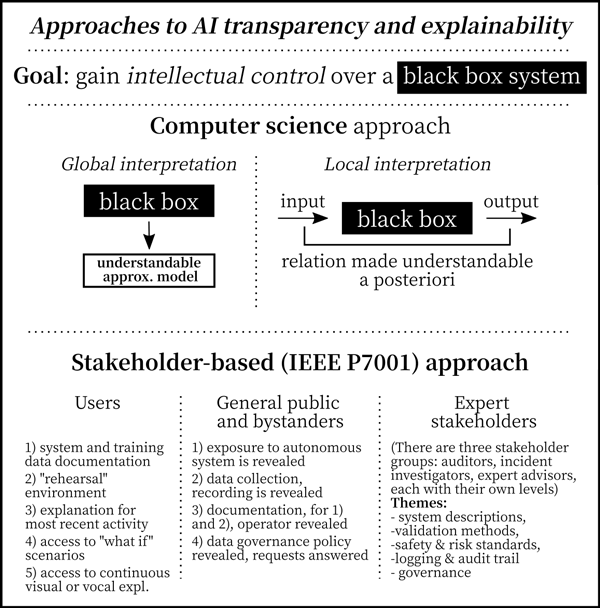by Mihály Héder (SZTAKI)
Understandability of computers has been a research topic from the very early days, but more systematically from the 1980s, when human-computer interaction started to take shape. In their book published in 1986, Winograd and Flores [1] extensively dealt with the issues of explanations and transparency. They set out to replace vague terms like “user-friendly”, “easy-to-learn” and “self-explaining” with scientifically grounded design principles. They did this by relying on phenomenology and, especially, cognitive science. Their key message was that a system needs to reflect how the user's mental representation of the domain of use is structured. From our current vantage point, almost four decades later, we can see that this was the user-facing variation of a similar idea, but for developers – object-oriented programming, a method on the rise at the time.
The 1980s precedes the now widespread success of machine learning at creating artificial intelligence (AI). In the days of “good old-fashioned” AI, with fewer tools and fewer computational resources, success was built on data structures and logic. These constraints resulted in systems that the creators and adaptors could keep under their intellectual oversight, or at least they knew it was possible to look under the hood and see exactly what was going on.
With machine learning, the designed structures and curated rulesets were replaced by machine-generated models. But, due to the nature of computers, every detail and bit of these models can still be examined easily. This posed a challenge from the terminological point of view: why would we call something a black box (a term Rosenblatt used in the context of artificial neural networks already in 1957, but for a single neuron) if every detail can be readily known? While the word “complexity” is sometimes used – quite confusingly due to its many adjacent meanings – it is more accurate to talk about the lack of understandability or not having adequate explanations about curious behaviour. Understanding is an epistemic value to be achieved by a human investigating a system; therefore, the term “epistemic opacity” [2] was introduced. The opposite of this is then (epistemic) transparency, a feature of a system that affords human understanding and intellectual oversight.
Machine learning, especially deep learning, does not produce models and systems built on these models with this feature, therefore, they create epistemic deficit. Yet, they are here to stay because of their performance. They need to be made transparent, then.
There are two main strategies to interpret, that is, understand these models: first, the entire model may be interpreted, in which case the resulting explanation is called “global” – continuing the tradition of poor choice of terminology in AI (alternatives could have been “comprehensive”, “broad”, etc.).
This can be achieved by a surrogate system, which helps by faithfully representing the original model while allowing for simplification, and uses elements that humans easily understand. If such a surrogate is successfully made, the entire model is made transparent. Moreover, we can predict its behaviour to imagined inputs before it happens, providing us with intellectual control. Other global explanations visualise the model or map out concepts used by a model. We can only speculate regarding the etymology, but most probably, this approach is called “global” because it is the apparent linguistic opposite of “local”. This word takes us to the second interpretation strategy, local interpretation. The usage of “local” is much better justified by the concept of local fidelity – it means that an explanation is made for one particular output of a system, but in a way that it may be used for similar inputs, where similarity is measured as the distance in a mathematical space. Therefore, we are talking here about true spatial locality.
This epistemic approach to transparency is inevitably relative to the knowledge of the particular persons trying to achieve intellectual oversight. This fact is best engaged by the IEEE P7001 standard draft [3], which is expected to become a harmonised EU standard as the EU AI Act; legislation that makes transparency (and therefore explainability) central, moves forward.
This approved draft uses a stakeholder-based approach and divides humans into “users”, the “general public” or “bystanders” (non-users who may still be affected), and “experts”. The last group is further divided into certification agencies and auditors, incident investigators and expert advisers in litigation. This draft is very helpful, as it clarifies that the mathematical method under the XAI umbrella term is for the experts, while user transparency may be created by layperson explanations, like for clustering the term “other users who listened to this also liked the following”. Agencies are catered for yet another, more administrative modus of transparency, tuned for accountability.
As transparency is widely believed to be essential to build trust, the methods to achieve it are here to stay, and therefore explainable AI has a long future.

Approaches to AI transparency and explainability
References:
[1] T. Winograd, F. Flores and F. F.Flores, Understanding Computers and Cognition: A New Foundation for Design, Intellect Books, 1986.
[2] M. Héder, “The epistemic opacity of autonomous systems and the ethical consequences,” AI & Society, 1–9, 2020.
[3] A. F. T. Winfield, et al., “IEEE P7001: A proposed standard on transparency,” Frontiers in Robotics and AI, vol. 8, 665729, 2021.
Please contact:
Mihály Héder, SZTAKI, Hungary











